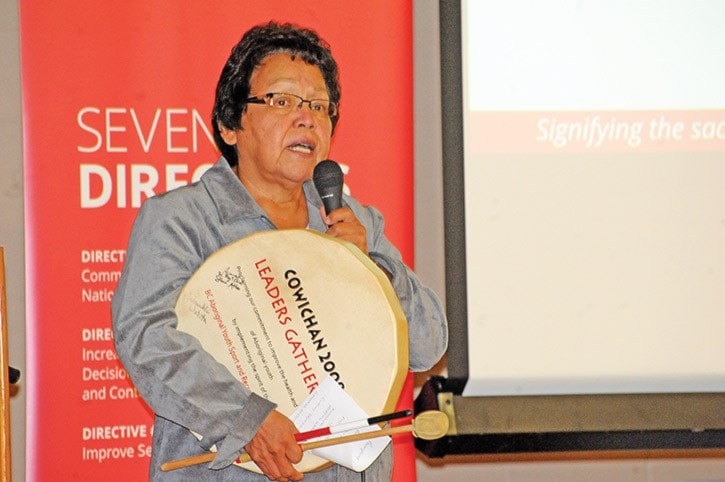While the national inquiry into missing and murdered Indigenous women inches forward, leaders from the Esk’etemc First Nation are not waiting to make positive changes in their community and others.
“We choose to be proactive,” Esk’etemc Chief Charlene Belleau told attendees at the recent First Nations Health Council caucus, held in Williams Lake last week.
Despite the inquiry being called, Belleau said she feels like nothing has changed in the way missing and murdered Indigenous women cases are treated and feels communities themselves must choose to live violence-free.
“Somehow it’s our responsibility to do something about it.”
So far, that desire for change has translated into physically assisting in the search for missing woman and girls such as helping the Splatsin First Nation at Enderby search for Caitlin Potts June 7. Potts, originally from Alberta, was reported missing March 1.
Esk’etemc members assisted in supporting the Potts family, took part in the search and helped put on a feast afterwards.
More recently, Esk’etemc also put a team of volunteers together and headed out to the Miocene area in September to help search for missing 16-year-old Amy Char, who was alone in the forest for four nights before making her way home “very cold and frozen, but alive.”
On Oct. 11, Belleau led community members and the RCMP to the banks of the Taseko River in Tsilhqot’in territory where they met with Xeni Gwet’in Chief Roger William and conducted a ceremony to reignite the search for Jackie Bob.
Bob is one of the woman listed on the national inquiry. The search and investigation into her disappearance began 12 years ago in the summer of 2004, after the 41-year-old woman was last seen while mushroom picking with friends in the Brittany Triangle area of the Nemiah Valley.
At the time, an extensive week-long ground and air search was conducted, however, Bob was never located.
Belleau said her community will conduct a new search for Bob in the spring of 2017 in an effort to find answers and give some closure to the victim’s family.
Belleau said she supports vigils but would rather be out searching for those missing and making changes individually and as communities to protect woman and girls.
“To me there are a lot of simple, practical things to stop this violence toward our women.”
Belleau said communities can schedule one day every year where they search local roads for those missing, they can become familiar within their own regions as to who is missing or murdered, community leaders can co-ordinate men’s healing circles, women can support men’s healing journeys and communities can educate children to respect their mothers, grandmothers and sisters.
Before Belleau concluded her speech, she had all the attendees at the conference, as many as 100, take part in a moving ceremony to vow to live violence-free lives and to support their communities in protecting women and girls.
The National Inquiry into Missing and Murdered Indigenous Women
The inquiry’s commissioners are required to examine and report on the systemic causes behind the violence that Indigenous women and girls experience, and their greater vulnerability to violence, by looking for patterns and underlying factors that explain why higher levels of violence occur.
The commissioners have been mandated to examine the underlying historical, social, economic, institutional and cultural factors that contribute to the violence.
According to the Government of Canada’s website, the commission, which is independent of government, will examine practices, policies and institutions such as policing, child welfare, coroners and other government policies/ practices or social/economic conditions.
The commissioners, as part of their mandate, will examine and report on institutional policies and practices that have been put in place as a response to violence, including those that have been effective in reducing violence and increasing the safety of Indigenous women and girls.
